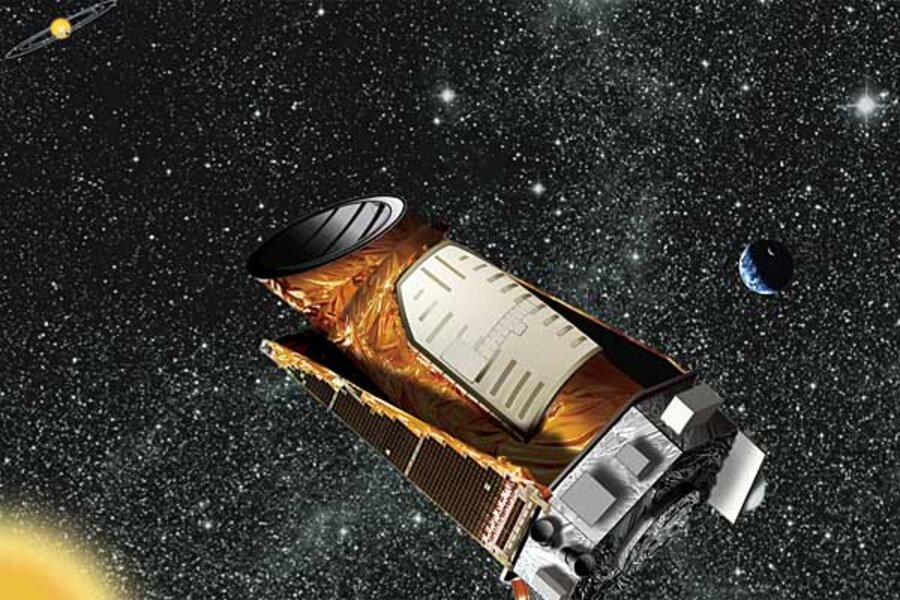Kepler telescope finds two planets – and a possible new use
Loading...
NASA's planet-hunting Kepler spacecraft has bagged its first multiple-planet solar system – two Saturn-size planets circling a star 2,283 light-years from Earth, in the constellation Lyra.
Moreover, the system may host a third planet, roughly 1.5 times Earth's size, orbiting the host star well inside the orbits of the other two.
"This is the first system of multiple transiting bodies that are confirmed to be planets," says planetary scientist Matthew Holman, who led the team reporting the results Thursday on Science Express, the online edition of the journal Science.
By transiting, Dr. Holman is referring to the way the planets dim the light from their host stars as the planets swing in front of the star from Earth's perspective.
The announcement comes on the heels of another earlier this week of a solar system hosting five Neptune-like planets, very close to their parent star -- and potentially hosting a "super-Earth" at roughly the same distance as the Kepler group's innermost "candidate" orbits.
In Kepler's case, the newfound planets both are slightly smaller and less massive than Saturn. Both orbit the star, dubbed Kepler 9, at a distance that would fall well within Mercury's orbit if they were orbiting the sun.
For Kepler 9b, the innermost of the confirmed planets, one trip around its star takes about 19 days. The planet's average temperature is estimated at a toasty 872 degrees Fahrenheit. Kepler 9c, the outer of the two, spends 39 days making a complete orbit and registers a somewhat cooler 512 degrees F. Both are thought to be made of hydrogen and helium.
If the third object turns out to be a planet, and not a false reading of some sort, the team estimates that it would be roughly 1.5 times the size of Earth. But it's far too close to its star to be much more than a barren target for intense radiation.
The team estimates that the planets have been in these stable orbits for some 2.7 billion years.
The Kepler mission's goal is to monitor more than 156,000 sun-like stars for three years, with the goal of seeing how many of those stars have Earth-like planets at Earth-like distances – within a star's so-called habitable zone. The telescope launched in March 2009 is designed to use the transit method to detect planets. So far, Kepler, which orbits the sun some 18 million miles from Earth, has detected more than 700 planet "candidates" among the stars it is scanning.
Most of the extrasolar planets found so far have been found by methods such as detecting the wobble a planet's gravity imparts to the star as the planet orbits. But increasing numbers of extrasolar planets are being discovered via the transit technique – a trend that Kepler is expected to turbocharge.
This discovery gives planetary scientists one more oddball solar system to study.
"Such systems are important," says Dr. Holman, a researcher at the Harvard-Smithsonian Center for Astrophysics in Cambridge, Mass. "They allow us to study how planets with different physical characteristics might form and evolve around the same star. It also allows us to compare other planetary systems with our own solar system to understand those processes."
But Kepler's find also shows that the craft may be a much more powerful planet-hunting tool than people thought – one whose data will allow scientists to build an initial, coarse description of planets in a system without the aid of ground-based follow-up observations, although these will still be needed for detailed studies.
Two planets orbiting the same star will appear to accelerate or slow their orbit times as each planet's gravity affects the other's motion. Kepler can pick up these changes. Combined with other traits its data can reveal, Kepler's output can yield information on the planets' masses, size, density, temperature, and gross composition – gas balls or rocky orbs.
The ability to detect gravitational disturbances of orbits also implies that Kepler will be able to signal the presence of additional planets that do not transit, merely from recording changes in the orbital speeds of the planets it can detect.
"Using transit-timing variations, astronomers have a new tool for confirming some planetary systems much more efficiently than before," notes University of Florida astronomer Eric Ford, a member of the team reporting the results.





